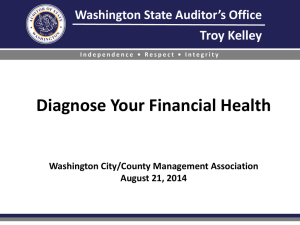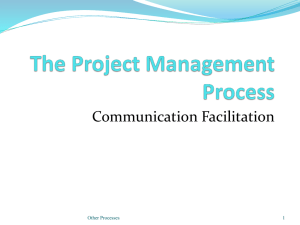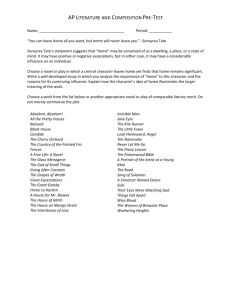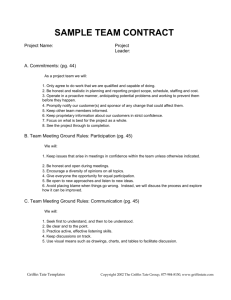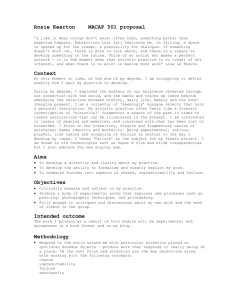Fraud Prevention, Detection, and Internal Controls Budget, Accounting and Reporting Council
advertisement
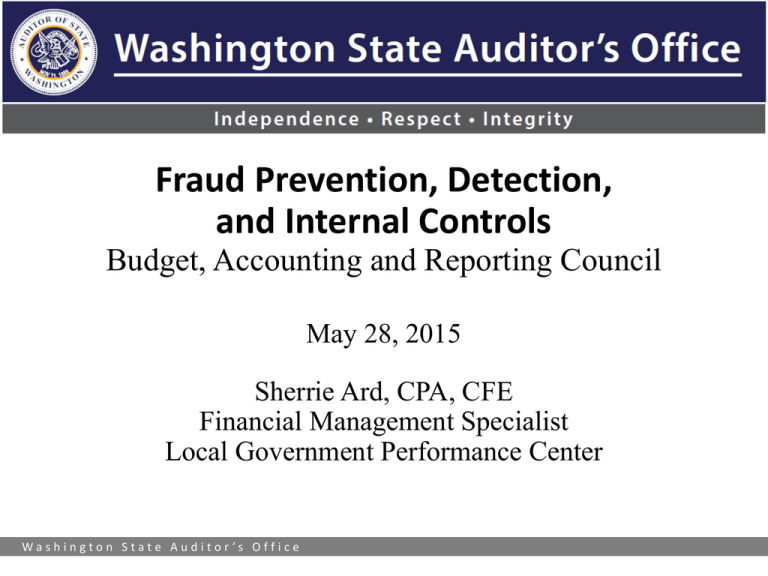
Fraud Prevention, Detection, and Internal Controls Budget, Accounting and Reporting Council May 28, 2015 Sherrie Ard, CPA, CFE Financial Management Specialist Local Government Performance Center Wa s h i n gto n S tate A u d i to r ’s O ff i c e Local Government Performance Center Offers training and resources to: Help local governments evaluate programs and services Performance measurement Improve the value of services to citizens Lean academy Communicate with citizens Financial management and Technical Assistance No cost to local governments Wa s h i n gto n S tate A u d i to r ’s O ff i c e 2 FRAUD Wa s h i n gto n S tate A u d i to r ’s O ff i c e 3 Objectives Fraud overview and statistics Why internal controls are important Common cash receipting and payment schemes Case studies Purchase cards – next big thing What to do if fraud happens to you Wa s h i n gto n S tate A u d i to r ’s O ff i c e 4 Fraud Statistics and overview Wa s h i n gto n S tate A u d i to r ’s O ff i c e 5 2014 ACFE report to the nations Wa s h i n gto n S tate A u d i to r ’s O ff i c e 6 How occupational fraud is committed Association of Certified Fraud Examiners’ research into occupational fraud has revealed consistent and clear patterns about the form fraud schemes take and the relative cost of each scheme type. Wa s h i n gto n S tate A u d i to r ’s O ff i c e 7 Occupational fraud categories Asset Misappropriation 85.4% Wa s h i n gto n S tate A u d i to r ’s O ff i c e Corruption Financial Statement Fraud 36.8% 9% 8 Occupational fraud and abuse Typical organization loses 5% of revenues each year to fraud Global loss to fraud $3.7 trillion Wa s h i n gto n S tate A u d i to r ’s O ff i c e 9 Victim organizations 17.8% - Banking and financial services 10.3% - Government and public administration 8.5% - Manufacturing Median loss in study was $145,000 (22% lost at least $1 mil) Median duration until detection was 18 months Wa s h i n gto n S tate A u d i to r ’s O ff i c e 10 2014 State Auditor’s Reports 2014 misappropriation by category $244,445 Total $279,938 $797,302 $222,116 $50,803 payroll Other Wa s h i n gto n S tate A u d i to r ’s O ff i c e Payments Cash receipting 11 Method of detection Category Percentage Tip 42.2% Management review 16.0% Internal audit 14.1% By accident 6.8% Reconciliation process 6.6% Examine documents 4.2% External audit 3.0% Surveillance 2.6% Notified by law enforcement 2.2% IT controls 1.1% Confession 0.8% Other 0.5% Wa s h i n gto n S tate A u d i to r ’s O ff i c e 12 Occupational fraud and abuse The higher the perpetrator’s level of authority, the greater the loss The presence of anti-fraud controls is associated with: Reduced fraud losses Shorter duration Wa s h i n gto n S tate A u d i to r ’s O ff i c e 13 Association of Certified Fraud Examiners Fraud Triangle RATIONALIZATION Wa s h i n gto n S tate A u d i to r ’s O ff i c e 14 Internal Controls Wa s h i n gto n S tate A u d i to r ’s O ff i c e 15 What is internal control? Internal controls are the practical techniques employed by management to accomplish its objectives and meet its responsibilities. Internal controls are essentially an inextricable part of how management conducts its business. Management (not the internal or external auditors) is primarily responsible for the effectiveness of internal controls. It is a basic principle of good management that authority and responsibility should not be separated. ~GFOA Wa s h i n gto n S tate A u d i to r ’s O ff i c e 16 COSO Framework Committee of Sponsoring Organizations of the Treadway Commission (COSO) Framework Control environment Risk assessment Control activities Information and communication Monitoring Wa s h i n gto n S tate A u d i to r ’s O ff i c e 17 Framework of internal controls should: 1. Create & maintain an environment conducive to control 2. Ensure that risks from inside and outside the entity are assessed and managed on an ongoing basis 3. Result in the design and implementation of appropriate policies and procedures 4. Provide for the appropriate communication of information both inside and outside the entity 5. Monitor the effectiveness of control-related policies and procedures as well as the resolution of potential problems identified by controls Wa s h i n gto n S tate A u d i to r ’s O ff i c e 18 Designing internal controls Management is in a position to establish and maintain internal controls and is held primarily accountable for their proper functioning. When designing/establishing internal controls break the system into locations and segments. Evaluate: Will I be able to identify a loss? Will I identify the entire loss? Will I be able to identify who is responsible? Wa s h i n gto n S tate A u d i to r ’s O ff i c e 19 Why are internal controls important? Effective internal controls Protect employees Safeguard public resources Assist in fraud prevention Wa s h i n gto n S tate A u d i to r ’s O ff i c e 20 Common Cash Receipting Schemes Wa s h i n gto n S tate A u d i to r ’s O ff i c e 21 Common Cash Receipting Schemes: Theft of cash before it is recorded Theft of cash after recorded in the records Skimming Larceny Wa s h i n gto n S tate A u d i to r ’s O ff i c e 22 Theft of cash before it is recorded Unrecorded cash receipts Theft of incoming checks Check for cash substitution Lapping Funds disappear from safe Theft of cash after it is recorded Use of co-worker’s access False voids or refunds Adjustments or “discounts” Missing deposit Study Cash receipting January 1, 2005 – January 4, 2011 Wa s h i n gto n S tate A u d i to r ’s O ff i c e 25 Case study How was it detected? A County employee was comparing Probation Services transmittal information to the amount recorded by the Treasurer’s Office and determined deposits were late. Wa s h i n gto n S tate A u d i to r ’s O ff i c e 26 Case study What did we find? Misappropriation totaled at least $62,150 Amount Category (Misappropriation and Questionable) $51,816 Fees not deposited (M) $10,334 Checks substituted for cash removed from the deposit (M) $30,772 Unsupported voids and cash shortages (Q) $734,894 Adjustments to customer accounts (Q) Wa s h i n gto n S tate A u d i to r ’s O ff i c e 27 Case study How was the fraud concealed? One employee was responsible for both collecting and reconciling daily cash receipts as well as making bank deposits Bank deposits were not made within 24 hours as required by state law (RCW 43.09.240) Destruction of records Wa s h i n gto n S tate A u d i to r ’s O ff i c e 28 Case study Lessons Learned: Trusted employee, with complete access to key systems, including cash-receipting, bank deposits and account adjustments. No one independently monitored cash/check composition or adjustments. No one reconciled the system transactions, manual receipts or collection agency payments with the bank deposits. Wa s h i n gto n S tate A u d i to r ’s O ff i c e 29 Case study What happened to the employee? Found guilty by a jury verdict of nine counts of seconddegree theft and one count of misappropriation of accounts by a public officer. Wa s h i n gto n S tate A u d i to r ’s O ff i c e 30 Case study Were there any red flags? Trusted employee with complete access and very little monitoring Modes did not agree Lack of supporting records High volume of voids/adjustments Deposits not made timely Wa s h i n gto n S tate A u d i to r ’s O ff i c e 31 Cash handling controls Documented policies and procedures should be communicated directly from management. Segregation of duties - one individual should not have control over the entire accounting transaction (authorization, recording and custody) Mail should be opened by someone independent of cashier, accounts receivable bookkeeper, or other accounting employees who may initiate or post journal entries. Wa s h i n gto n S tate A u d i to r ’s O ff i c e 32 Cash handling controls Is the cashier restricted from gaining access to the accounts receivable records and bank and customer statements? Is the person who makes postings to the general ledger independent of the cash receipts and accounts receivable functions? Does a person independent of the cashier or accounts receivable functions handle customer complaints? Are areas where physical handling of cash takes place reasonably safeguarded? Wa s h i n gto n S tate A u d i to r ’s O ff i c e 33 Cash handling controls Review receipt sequence. Are receipts used in sequential order? Are all the receipt numbers accounted for? Are cash receipts deposited intact daily? Safeguard and limit access to receipts awaiting deposit. How long has it been since the safe combination was changed? Review bank reconciliations. Are they timely? Do reconciling items make sense? Wa s h i n gto n S tate A u d i to r ’s O ff i c e 34 Cash handling controls Compare bank deposits to receipt records and verify the modes of payment agree. Does the total deposit make sense? Look for deposits not made daily or intact. Create and review error reports. (voids and adjustments) Are they authorized, supported and legitimate? Perform surprise cash counts Are employees who handle receipts bonded? Wa s h i n gto n S tate A u d i to r ’s O ff i c e 35 Cash Handling controls Spot check customer accounts, such as utilities. Are payments posted timely to the correct account in the correct amount? Customer billings should detail the prior balance, payments made, adjustments to the account and the current amount due. Review employee account activity. Review security deposit refunds. Wa s h i n gto n S tate A u d i to r ’s O ff i c e 36 Cash receipting misappropriations A School District employee misappropriated at least $20,463 by not depositing cash payments that were paid for District services. He also did not pay for services that he received. A City office technician, working as a cashier at a Community Center misappropriated at least $14,491 by canceling valid transactions and removing the cash. Wa s h i n gto n S tate A u d i to r ’s O ff i c e 37 Common Payment Schemes Wa s h i n gto n S tate A u d i to r ’s O ff i c e 38 Personal Purchases Items for personal use delivered to the entity or employee’s residence Wa s h i n gto n S tate A u d i to r ’s O ff i c e 39 Purchase and Return Step 1: Purchase items. Step 2: Fraudster returns items and keeps the cash, check or gift card Wa s h i n gto n S tate A u d i to r ’s O ff i c e 40 Fictitious Vendor Employee sets up a business or uses an existing, legitimate business as a front Wa s h i n gto n S tate A u d i to r ’s O ff i c e 41 Direct Pay Make a check payable to themselves or transfer funds into their account Wa s h i n gto n S tate A u d i to r ’s O ff i c e 42 Employee Reimbursements Reimbursement for personal purchases, inflated mileage, travel that didn’t happen or duplicate payments Wa s h i n gto n S tate A u d i to r ’s O ff i c e 43 • • • • • Accounts payable system Manual warrants Electronic transfers Advanced travel Revolving or imprest accounts • Petty cash • Open vendor accounts • Credit or purchase cards The next big thing? What is our prediction for largest scheme type in 2015? Procurement and credit cards Preview of lessons learned Wa s h i n gto n S tate A u d i to r ’s O ff i c e 45 How to avoid credit/purchase card fraud? Develop a written policy Allowable uses Prohibited uses No personal use Responsibilities What happens if policy is not followed Have everyone with card responsibilities sign off on policy Wa s h i n gto n S tate A u d i to r ’s O ff i c e 46 How to avoid credit/purchase card fraud? Records Require original, itemized receipts Think about who will be responsible for retaining them Where are they stored? Banking controls Consider setting a monthly limit Consider limiting allowable vendors Ask if supervisors/AP can have read-only access into credit card account Wa s h i n gto n S tate A u d i to r ’s O ff i c e 47 How to avoid credit/purchase card fraud? Review—Who is responsible for what? Employee Supervisor knowledgeable of activities Accounts payable Documentation of review Step back analysis Who actually needs a card? Is the volume of transactions necessary and reasonable? Does the credit card holder ask for personal reimbursements? Wa s h i n gto n S tate A u d i to r ’s O ff i c e 48 Study Payments June 2008 – August 2010 Wa s h i n gto n S tate A u d i to r ’s O ff i c e 49 Case study How was it detected? Management noticed unusual transactions on the Department’s Corporate Travel Account while the former employee was on vacation. It determined the charges were personal charges. Wa s h i n gto n S tate A u d i to r ’s O ff i c e 50 Case study What did we find? Misappropriation totaled at least $252,059 Amount Category $204,340 Procurement card purchases $ 39,350 Travel card purchases $ 1,612 Personal or already reimbursed charges $ 6,757 Unearned leave Wa s h i n gto n S tate A u d i to r ’s O ff i c e 51 Case study How was the fraud concealed? The employee’s job responsibilities were not segregated. One person was responsible for approving, processing, monitoring and reconciling transactions which included procurement card and corporate travel charges. The online procurement card system allowed any authorized user to perform both the cardholder and reconciler certification that charges were appropriate. As a result, the Administrative Manager routinely performed both certifications. The former employee circumvented controls by using falsified documents to request an increase in his procurement card limit. Wa s h i n gto n S tate A u d i to r ’s O ff i c e 52 Case study Lessons Learned: Management did not sufficiently oversee and review the employee’s procurement card activities. Actual travel charges were not reviewed for the employee whose job responsibilities rarely required travel on official business. The employee circumvented controls by falsifying records and requesting reimbursement for personal travel and previously reimbursed expenses to another individual. Management did not require employee to submit leave slips when taking time off and ensure that the leave was recorded on the timesheets, reconciled to leave slips and deducted from leave balance. Wa s h i n gto n S tate A u d i to r ’s O ff i c e 53 Case study What happened to the employee? Charged with seven counts of first-degree theft and 12 counts of second-degree theft. Wa s h i n gto n S tate A u d i to r ’s O ff i c e 54 Case study Were there any red flags? Trusted employee with complete access and very little monitoring Lack of supporting records Credit card had high transaction limit Employee had access to the travel account but did not travel as part of job duties At the time of hire, the employee was facing felony theft charges for another incident and had a criminal conviction for theft in another state Wa s h i n gto n S tate A u d i to r ’s O ff i c e 55 Payment misappropriations An city recreation program coordinator who was in a supervisory role, created a fictitious company on PayPal and used purchase cards assigned to other employees to make at least $117,410 in purchases from the vendor. A university financial accountant recorded fake vendor expenses in order to wire payments to her personal account as well as accounts of her sister and a friend, which led to a loss totaling $56,000. Wa s h i n gto n S tate A u d i to r ’s O ff i c e 56 Payments internal controls Establish policies and procedures and ensure they are enforced (practice = policy) Scanned documents Only pay original invoices Ensure payments made outside normal process are approved, supported and for a public purpose Wa s h i n gto n S tate A u d i to r ’s O ff i c e Purchase card internal controls Review credit card bills and support documentation to ensure the purchases are approved, supported and for a public purpose Take a step back and look at your credit card use. Is it appropriate and necessary? Establish written agreements with banks, to include processing procedures, and security requirements Wa s h i n gto n S tate A u d i to r ’s O ff i c e Purchase card internal controls Adopt written policies and procedures for internal staff Employee responsibility communicated and signed Ongoing training Periodic audits of card activity and documentation of purchases by vendor Timely reconciliation by cardholders and supervisors Segregation of duties for payment approvals accounting and reconciliations Wa s h i n gto n S tate A u d i to r ’s O ff i c e General fraud prevention Establish strong policies and ensure staff are trained Let them know you are looking Segregation of duties Cross train duties Mandatory vacations Wa s h i n gto n S tate A u d i to r ’s O ff i c e 60 Fraud happens What to do if it happens to you: Immediately notify State Auditor’s Office Don’t wait – do it Wa s h i n gto n S tate A u d i to r ’s O ff i c e 61 “State agencies and local governments shall immediately report to the state auditor’s office known or suspected loss of public funds or assets or other illegal activity. “ Wa s h i n gto n S tate A u d i to r ’s O ff i c e 62 Fraud happens What to do if it happens to you: Fill out a report on the Web at www.sao.wa.gov | Investigations | Fraud Program | Report a Suspected Fraud (RCW 43.09.185). It only takes a few minutes! Wa s h i n gto n S tate A u d i to r ’s O ff i c e 63 Wa s h i n gto n S tate A u d i to r ’s O ff i c e 64 Do’s and Don’ts Wa s h i n gto n S tate A u d i to r ’s O ff i c e 65 Fraud happens What to do if it happens to you: Do consider filing a police report (consult the State Auditor’s Office about timing). Don’t enter into a restitution agreement with an employee (State Auditor and Attorney General written approval is required, RCW 43.09.260). Wa s h i n gto n S tate A u d i to r ’s O ff i c e 66 Fraud happens What to do if it happens to you: Do protect accounting records from loss or destruction. Don’t try to be the investigator. But do start a record and or timeline: how it came to your attention, records of conversations, etc. Wa s h i n gto n S tate A u d i to r ’s O ff i c e 67 Fraud happens What to do if it happens to you: Do remove access to financial system, bank account and credit cards. Don’t physically prevent an employee from leaving the room or leaving the building. Wa s h i n gto n S tate A u d i to r ’s O ff i c e 68 Fraud happens What to do if it happens to you: Do ensure personnel action is taken for violating policies and procedures, NOT for misappropriating public funds. Don’t agree to let the employee repay money to “make it go away.” Wa s h i n gto n S tate A u d i to r ’s O ff i c e 69 Summary Remember the fraud triangle Effective controls can limit the opportunity When designing internal controls, break down the system into segments and analyze: If you could identify a loss If you could identify who is responsible. Wa s h i n gto n S tate A u d i to r ’s O ff i c e RATIONALIZATION 70 Summary Beware of the “trusted employee” trap Who has the most access to funds? Sometimes good people do bad things. Remember your auditor doesn’t review every transaction. Don’t rely on auditors to find the fraud. That is your job! Wa s h i n gto n S tate A u d i to r ’s O ff i c e 71 Contacts Sarah Walker, CFE Fraud Manager (509) 454-3621 Sarah.Walker@sao.wa.gov Sherrie Ard, CPA, CFE Local Government Performance Center (360) 260-6408 Sherrie.Ard@sao.wa.gov Wa s h i n gto n S tate A u d i to r ’s O ff i c e 72
